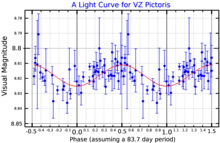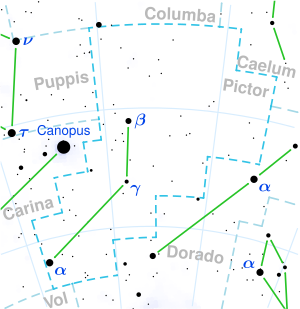Kapteyn's Star
| Observation data EpochJ2000EquinoxJ2000 | |
|---|---|
| Constellation | Pictor |
| Right ascension | 05h11m40.58984s[1] |
| Declination | −45° 01′ 06.3617″[1] |
| Apparent magnitude(V) | 8.853±0.008[2] |
| Characteristics | |
| Spectral type | sdM1[3]or M1.5V[2][4] |
| U−Bcolor index | +1.21[5] |
| B−Vcolor index | 1.57±0.012[2] |
| Variable type | BY Dra[6] |
| Astrometry | |
| Radial velocity(Rv) | 245.05±0.13[1]km/s |
| Proper motion(μ) | RA:+6,491.223mas/yr[1] Dec.:−5,708.614mas/yr[1] |
| Parallax(π) | 254.1986 ± 0.0168mas[1] |
| Distance | 12.8308 ± 0.0008ly (3.9339 ± 0.0003pc) |
| Absolute magnitude(MV) | 10.89[3] |
| Details[2] | |
| Mass | 0.281±0.014M☉ |
| Radius | 0.291±0.025R☉ |
| Luminosity | 0.012L☉ |
| Surface gravity(logg) | 4.96±0.13cgs |
| Temperature | 3,570±80K |
| Metallicity[Fe/H] | −0.86±0.05dex |
| Rotation | 124.71±0.19d[7] |
| Rotational velocity(vsini) | 9.15[8]km/s |
| Age | 11.5+0.5 −1.5Gyr |
| Other designations | |
| Database references | |
| SIMBAD | The star |
| planet b | |
| planet c | |
Kapteyn's Staris aclass M1redsubdwarfabout 12.83light-yearsfrom Earth in the southernconstellationPictor;it is the closesthalostar to theSolar System.With anapparent magnitudeof nearly 9, it is visible throughbinocularsor atelescope.[9]
Its diameter is 30% of theSun's, but itsluminosityjust 1.2% that of theSun.It may have once been part of theglobular clusterOmega Centauri,itself the likely core of a dwarf galaxy swallowed up by theMilky Wayin the distant past. The discovery of two planets—Kapteyn b and Kapteyn c—was announced in 2014,[10]but had a mixed history of rejections and confirmations, until a 2021 study refuted both planets. The "planets" are in fact artifacts of the star's rotation and activity.[7]
History of observations[edit]

Attention was first drawn to what is now known as Kapteyn's Star by the Dutch astronomerJacobus Kapteynin 1898.[11]Under the name CPD-44 612 it was included in theCape photographicDurchmusterungfor the equinox 1875 (−38 to −52)byDavid Gilland Jacobus Cornelius Kapteyn in 1897.[12]This catalogue was based on Gill's observations from theCape Observatoryin 1885–1889 and was created in collaboration with Kapteyn. While he was reviewing star charts and photographic plates, Kapteyn noted that a star, previously catalogued in 1873 byB. A. Gouldas C.Z. V 243,[13]seemed to be missing. However,Robert T. A. Innesfound an uncatalogued star about 15arcsecondsaway from the absent star's position. It became clear that the star had a very highproper motionof more than 8 arcseconds per year and had moved significantly. Later, CPD-44 612 came to be referred to as Kapteyn's Star[14]although equal credit should be accorded toRobert Innes.[15]At the time of its discovery it had the highest proper motion of any star known, dethroningGroombridge 1830.In 1916,Barnard's Starwas found to have an even larger proper motion.[14][16][17]In 2014, two super-Earth planet candidates in orbit around the star were announced,[10]but later refuted.[7]
Characteristics[edit]

Based uponparallaxmeasurements, Kapteyn's Star is 12.83light-years(3.93parsecs) from theEarth.[1]It came within 7.0 ly (2.1 pc) of theSunabout 10,900 years ago and has been moving away since that time.[18]Kapteyn's Star is distinctive in a number of regards: it has a high radial velocity,[14]orbits theMilky Wayretrograde,[17]and is the nearest-knownhalostar to the Sun.[19]It is a member of amoving groupof stars that share a common trajectory through space, named the Kapteyn moving group.[20]Based upon theirelement abundances,these stars may once have been members ofOmega Centauri,aglobular clusterthat is thought to be the remnant of adwarf galaxythat merged with the Milky Way. During this process, the stars in the group, including Kapteyn's Star, may have been stripped away as tidal debris.[17][21][22]

Kapteyn's Star is between one quarter and one third the size and mass of the Sun and has a much coolereffective temperatureat about 3500 K, with some disagreement in the exact measurements between different observers.[17]Thestellar classificationis sdM1,[3]which indicates that it is asubdwarfwith a luminosity lower than that of amain-sequencestar at the same spectral type of M1. The abundance of elements other than hydrogen and helium, what astronomers term themetallicity,is about 14% of the abundance in the Sun.[23][24]It is avariable starof theBY Draconis typewith theidentifierVZ Pictoris. This means that the luminosity of the star changes because ofmagnetic activityin thechromospherecoupled withrotationmoving the resultingstar spotsinto and out of the line of sight with respect to the Earth.[6]
The star has a mass of 0.27M☉,a radius of 0.29R☉and has about 1.2% of the Sun's luminosity. It has a surface temperature of3,550Kand is roughly 11 billion years old.[10]In comparison, the Sun is about 4.6 billion years old[25]and has a surface temperature of 5,778 K.[26]Stars like Kapteyn's Star have the ability to live up to 100–200 billion years, ten to twenty times longer than the Sun will live.[27]
Search for planets[edit]
In 2014, Kapteyn's Star was announced to host two planets, Kapteyn b and Kapteyn c, based onDoppler spectroscopyobservations by theHARPSspectrometer which is housed at the European Southern Observatory'sLa Silla Observatoryin Chile, at theKeck Observatoryin Hawaii, and at thePFS Observatory,also in Chile.[28]Kapteyn b was described as the oldest-known potentiallyhabitable planet,estimated to be 11 billion years old,[10]while Kapteyn c was described as beyond the host star'shabitable zone.[29][30][10]
Kapteyn b was thought to make a complete orbit around its parent star about every 48.62 days at a distance of 0.17 AU, with an eccentricity of 0.21, meaning its orbit is mildly elliptical. Kapteyn c was thought to orbit with a period of 121.5 days at a distance of 0.31 AU, with an eccentricity of 0.23. Both planets were thought to besuper-Earths,withminimum massesof 4.8 and 7.0ME,respectively.[10]
The purported planets were thought to be close to a 5:2 periodcommensurability,but resonances could not be confirmed. Dynamical integration of the orbits suggested[10]that the pair of planets are in a dynamical state called apsidal co-rotation, which usually implies that the system is dynamically stable over long time scales.[31]Guinan et al. (2016) suggested that the present day star could potentially support life on Kapteyn b, but that the planet's atmosphere may have been stripped away when the star was young (~0.5 Gyr) and highly active.[2]The announcement of the planetary system was accompanied by a science-fiction short-story, "Sad Kapteyn", written by writerAlastair Reynolds.[32]
However, subsequent research by Robertson et al. (2015) found that the orbital period of Kapteyn b is an integer fraction (1/3) of their estimated stellar rotation period, and thus the planetary signal is most likely an artifact of stellar activity. The authors did not rule out the existence of Kapteyn c, calling for further observation.[33]This refutation was questioned by the team that published the exoplanet discovery paper.[34]Guinan et al. (2016) (as well as earlier authors) found a lower value for the stellar rotation, which lended support to the original planetary finding.[2]
In 2021, a new analysis found no evidence for either planet, and found that the observedradial velocitysignals are in fact artifacts of the star's rotation and activity, after the rotational period of the star was refined, with a rotational period very similar to that of candidate c.[7]There is currently no evidence for planets orbiting Kapteyn's Star.
See also[edit]
References[edit]
- ^abcdefVallenari, A.; et al. (Gaia collaboration) (2023)."GaiaData Release 3. Summary of the content and survey properties ".Astronomy and Astrophysics.674:A1.arXiv:2208.00211.Bibcode:2023A&A...674A...1G.doi:10.1051/0004-6361/202243940.S2CID244398875. Gaia DR3 record for this sourceatVizieR.
- ^abcdefgGuinan, Edward F.; Engle, Scott G.; Durbin, Allyn (April 2016), "Living with a Red Dwarf: Rotation and X-Ray and Ultraviolet Properties of the Halo Population Kapteyn's Star",The Astrophysical Journal,821(2): 14,arXiv:1602.01912,Bibcode:2016ApJ...821...81G,doi:10.3847/0004-637X/821/2/81,S2CID119283541,81.
- ^abcKoen, C.; et al. (April 2010), "UBV(RI)CJHK observations of Hipparcos-selected nearby stars ",Monthly Notices of the Royal Astronomical Society,403(4): 1949–1968,Bibcode:2010MNRAS.403.1949K,doi:10.1111/j.1365-2966.2009.16182.x.
- ^Demory, Brice-Olivier; Ségransan, Damien; Forveille, Thierry; Queloz, Didier; Beuzit, Jean-Luc; Delfosse, Xavier; Di Folco, Emmanuel; Kervella, Pierre; Le Bouquin, Jean-Baptiste; Perrier, Christian; Benisty, Myriam; Duvert, Gilles; Hofmann, Karl-Heinz; Lopez, Bruno; Petrov, Romain (October 2009), "Mass-radius relation of low and very low-mass stars revisited with the VLTI",Astronomy and Astrophysics,505(1): 205–215,arXiv:0906.0602,Bibcode:2009A&A...505..205D,doi:10.1051/0004-6361/200911976,S2CID14786643.
- ^ab"V* VZ Pic -- Variable Star",SIMBAD,Centre de Données astronomiques de Strasbourg,archivedfrom the original on 2016-03-03,retrieved2009-10-14..
- ^ab"VZ Pic",General Catalogue of Variable Stars,Sternberg Astronomical Institute,Moscow, Russia,archivedfrom the original on 2011-09-27,retrieved2009-10-14.
- ^abcdBortle, Anna; et al. (2021), "A Gaussian Process Regression Reveals No Evidence for Planets Orbiting Kapteyn's Star",The Astronomical Journal,161(5): 230,arXiv:2103.02709,Bibcode:2021AJ....161..230B,doi:10.3847/1538-3881/abec89,S2CID232110395.
- ^Houdebine, E. R. (September 2010), "Observation and modelling of main-sequence star chromospheres - XIV. Rotation of dM1 stars",Monthly Notices of the Royal Astronomical Society,407(3): 1657–1673,Bibcode:2010MNRAS.407.1657H,doi:10.1111/j.1365-2966.2010.16827.x.
- ^Kapteyn b and c: Two Exoplanets Found Orbiting Kapteyn's Star,Sci-News,archivedfrom the original on 3 August 2014,retrieved23 July2014.
- ^abcdefgAnglada-Escudé, Guillem; et al. (2014), "Two planets around Kapteyn's star: a cold and a temperate super-Earth orbiting the nearest halo red-dwarf",Monthly Notices of the Royal Astronomical Society: Letters,443:L89–L93,arXiv:1406.0818,Bibcode:2014MNRAS.443L..89A,doi:10.1093/mnrasl/slu076,S2CID67807856.
- ^Kapteyn, J. C.(1898),"Stern mit grösster bislang bekannter Eigenbewegung",Astronomische Nachrichten,145(9–10): 159–160,Bibcode:1897AN....145..159K,doi:10.1002/asna.18981450906..
- ^"Dictionary of Nomenclature of Celestial Objects",SIMBAD,Centre de Données astronomiques de Strasbourg, 2015-09-25, archived fromthe originalon 2015-09-25.
- ^Resultados del Observatorio Nacional Argentino,vol. 7, 1884, p. 98,Bibcode:1884RNAO....7...96..
- ^abcKaler, James B. (2002), "Kapteyn's Star",The Hundred Greatest Stars,Copernicus Books, pp. 108–109..
- ^Gill, D. (1899), "On the Discovery of a Certain Proper Motion",The Observatory:99–101.
- ^Barnard, E. E.(1916), "A small star with large proper motion",Astronomical Journal,29(695): 181,Bibcode:1916AJ.....29..181B,doi:10.1086/104156..
- ^abcdKotoneva, E.; et al. (2005), "A study of Kapteyn's star",Astronomy & Astrophysics,438(3): 957–962,Bibcode:2005A&A...438..957K,doi:10.1051/0004-6361:20042287..
- ^Bailer-Jones, C. A. L. (March 2015), "Close encounters of the stellar kind",Astronomy & Astrophysics,575:13,arXiv:1412.3648,Bibcode:2015A&A...575A..35B,doi:10.1051/0004-6361/201425221,S2CID59039482,A35.
- ^Woolf, V. M.;Wallerstein, G.(2004), "Chemical abundance analysis of Kapteyn's Star",Monthly Notices of the Royal Astronomical Society,350(2): 575–579,Bibcode:2004MNRAS.350..575W,doi:10.1111/j.1365-2966.2004.07671.x,S2CID15907478..
- ^Eggen, O. J.(December 1996), "The Ross 451 Group of Halo Stars",Astronomical Journal,112:2661,Bibcode:1996AJ....112.2661E,doi:10.1086/118210.
- ^Wylie-de Boer, Elizabeth; Freeman, Ken; Williams, Mary (February 2010), "Evidence of Tidal Debris from ω Cen in the Kapteyn Group",The Astronomical Journal,139(2): 636–645,arXiv:0910.3735,Bibcode:2010AJ....139..636W,doi:10.1088/0004-6256/139/2/636,S2CID119217292.
- ^"Backward star ain't from round here",New Scientist,November 4, 2009,archivedfrom the original on May 25, 2015,retrievedSeptember 2,2017.
- ^Woolf, Vincent M.; Wallerstein, George (January 2005), "Metallicity measurements using atomic lines in M and K dwarf stars",Monthly Notices of the Royal Astronomical Society,356(3): 963–968,arXiv:astro-ph/0410452,Bibcode:2005MNRAS.356..963W,doi:10.1111/j.1365-2966.2004.08515.x,S2CID15664454.
- ^The abundance is given by taking the metallicity to the power of 10. From Woolf and Wallerstein (2005), [M/H] ≈ –0.86 dex. Thus:
- 10−0.86= 0.138
- ^Cain, Fraser (16 September 2008),How Old is the Sun?,Universe Today,archived fromthe originalon 18 August 2010,retrieved19 February2011.
- ^Cain, Fraser (September 15, 2008),Temperature of the Sun,Universe Today, archived fromthe originalon 29 August 2010,retrieved19 February2011.
- ^Adams, Fred C.; Laughlin, Gregory; Graves, Genevieve J. M. (2004), "Red Dwarfs and the End of the Main Sequence",Gravitational Collapse: From Massive Stars to Planets,vol. 22, Revista Mexicana de Astronomía y Astrofísica, pp. 46–49,Bibcode:2004RMxAC..22...46A.
- ^Wall, Mike (3 June 2014),"Found! Oldest Known Alien Planet That Might Support Life",Space.com,retrieved10 January2015.
- ^Dickinson, David (June 4, 2014),"Discovered: Two New Planets for Kapteyn's Star",Universe Today.
- ^Kapteyn's Starat SolStations.com.
- ^Michtchenko, Tatiana A.; Rodríguez, Adrián (August 2011), "Modeling the secular evolution of migrating planet pairs",Monthly Notices of the Royal Astronomical Society,415(3): 2275–2292,arXiv:1103.5485,Bibcode:2011MNRAS.415.2275M,doi:10.1111/j.1365-2966.2011.18857.x,S2CID85449365.
- ^"Sad Kapteyn",Science fiction story released with the announcement of planetary system,Jun 4, 2014,archivedfrom the original on June 6, 2014,retrieved2014-06-04.
- ^Robertson, Paul; Roy, Arpita;Mahadevan, Suvrath(June 2015), "Stellar activity mimics a habitable-zone planet around Kapteyn's star",The Astrophysical Journal Letters,805(2): 6,arXiv:1505.02778,Bibcode:2015ApJ...805L..22R,doi:10.1088/2041-8205/805/2/L22,S2CID117871083,L22.
- ^Anglada-Escudé, G.; Tuomi, M.; Arriagada, P.; Zechmeister, M.; Jenkins, J. S.; Ofir, A.; Dreizler, S.; E. Gerlach; Marvin, C. J. (2016),"No Evidence for Activity Correlations in the Radial Velocities of Kapteyn's Star",The Astrophysical Journal,830(2): 74,arXiv:1506.09072,Bibcode:2016ApJ...830...74A,doi:10.3847/0004-637X/830/2/74,hdl:2299/17695,ISSN0004-637X,S2CID14348277.
Further reading[edit]
- Luyten, W. J.(1927), "Note on the magnitude and spectrum of Kapteyn's star",Harvard College Observatory Bulletin,843:3–4,Bibcode:1927BHarO.843....3L.
- MacConnell, D. J. (1973), "The spectrum and colors of Kapteyn's star",Bulletin of the American Astronomical Society,5:346,Bibcode:1973BAAS....5..346M.
- Murdin, Paul, ed. (2001), "Kapteyn's Star",Encyclopedia of Astronomy and Astrophysics,Bristol: Institute of Physics Publishing,doi:10.1888/0333750888/5156,ISBN0-333-75088-8.
- Perryman, Michael (2010),The Making of History's Greatest Star Map,Astronomers' Universe, Heidelberg: Springer-Verlag,Bibcode:2010mhgs.book.....P,doi:10.1007/978-3-642-11602-5,ISBN978-3-642-11601-8.
- Wing, R. F.; Dean, C. A.; MacConnell, D. J. (1976), "The temperature, luminosity, and spectrum of Kapteyn's star",The Astrophysical Journal,205:186–193,Bibcode:1976ApJ...205..186W,doi:10.1086/154263.
External links[edit]

